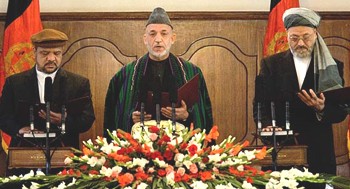On 7 October 2001, the US-led invasion of Afghanistan began. Barely a month later, Kabul fell to the Northern Alliance. It was, it seemed to observers at the time, a short and relatively painless conflict. A new type of war that relied on using proxy local militia commanders and the power of the American air force appeared to have been fought with ease. No sooner had the world been made to take notice of the Taliban than they were defeated.

President Karzai takes the oath of office alongside Mohammad Qasim Fahim, left, and Karim Khalili, right, his vice-presidents. Both are well-known brutal warlords who made Kabul a bloodbath in the 1992-1996 civil war. (Photo: Paula Bronstein/Getty Images)
Today, that first autumn after 9/11 has long faded into memory for the people of Afghanistan. At best, it conjures up the same kind of sad emotions as an old photograph. At worst, it feels like a sham: a bitter prologue to yet another story of occupation and bloodshed. Much of what has happened since can be traced to that early period, when the war was painted just in black and white. Even then, victory was not certain and the boundaries between right and wrong, good and evil, were never clear-cut.
The questions being raised about the conflict now could, and should, have been asked at the very start. The seeds of the Taliban’s resurgence and the corruption of the Karzai administration were planted immediately, when many of the US troops who later died here were only children.
Relying on the Northern Alliance certainly meant that few US citizens were initially put in harm’s way in a country known for its hatred of foreign invaders. But it also demonstrated a profound or wilful ignorance of another aspect of Afghan history: the same militia commanders financed and supported by Washington in 2001 were already systematic human rights abusers whose actions had helped inspire the original formation of the Taliban movement.
From 1992-96, their fighters razed Kabul to the ground, killing tens of thousands of civilians. Under their leadership, homes were looted, women raped and men kidnapped and tortured. Abdul Rashid Dostum, a key Northern Alliance figure for the Americans, was among them. An ethnic Uzbek, he is also accused of massacring prisoners of war while working for the US during the invasion — something Pashtuns still mention when asked why they oppose the occupation. He has a ceremonial position in the Karzai government.
Mohammad Qasim Fahim, who swept his forces into Kabul in 2001, is well known for his hand in the chaos of the 1990s. He is now first vice-president.Other prominent figures in modern Afghan politics played a central role in the carnage and sectarian divisions of recent history. A number of them ran in September’s parliamentary election, which has become mired in allegations of widespread fraud.
When members of a High Peace Council set up to facilitate negotiations with the insurgents were named last week, they included individuals despised by the Taliban and their sympathisers, making a mockery of any claim that it can orchestrate a serious breakthrough. On the list was Burhanuddin Rabbani, president from 1992-96, Abdul Rab Rasul Sayyaf, a notorious former mujahid, and Haji Mohammed Mohaqiq, a Shia leader whose party has been accused of human rights atrocities. All have been clients, in one form or another, of the US.
Rather than usher in a new beginning, the 2001 invasion resurrected the ghosts of the past and laid the groundwork for what may yet be a brutal civil war in the years ahead.
The first captives started arriving at Guantanamo Bay from Afghanistan in January 2002. Others were held without charge or trial in the detention centre at Bagram air base, north of Kabul. The Taliban could not have wished for a better propaganda tool to fuel their recruitment drive and set the insurgency in motion. Despite some cosmetic changes, the US still keeps prisoners at both facilities in conditions that anger and disgust Afghans. Too often, people also continue to be rounded up or killed by American and Nato troops on the basis of faulty intelligence information — a pattern that is as old as the war.
Pessimists foresaw today’s scenario in the build-up to the invasion. After it, even those who were cautiously optimistic should have had doubts. By 2005 it was obvious to anyone watching closely that the situation was deteriorating fast.
The Taliban were never defeated. Instead, they melted away and bided their time, as all successful guerrilla movements do. Their return, through force or a political deal, seems inevitable. Whether thousands of lives could have been saved by genuinely trying to negotiate with them nine yeas ago is just one of the questions it is too late to ask.
Improvements to some aspects of Afghan society that were ushered in by the invasion came at considerable cost, to the country, its foreign allies and the region. In the case of women’s rights, they are also grossly exaggerated.
This war has lasted longer than America’s overt military campaign in Vietnam and coincided with a period of domestic economic meltdown in the US. Al-Qaida and the Taliban have spread into Pakistan, a nuclear state which is more volatile than ever before. Meanwhile, Afghanistan is experiencing some of the most frightening insecurity it has known. A new generation of young men have been radicalised and learned to hate western-style democracy just as their fathers hated communism. The rebels are increasingly picking up support in northern provinces, away from their heartlands in the south and east.
People here fear the situation will get even worse. Unlike in 2001, there is no real hope anymore — just varying degrees of anger and anxiety. Nine years on, Afghans are scared — of the Taliban, of the warlords, of the foreign troops, of their government, and of the future.



